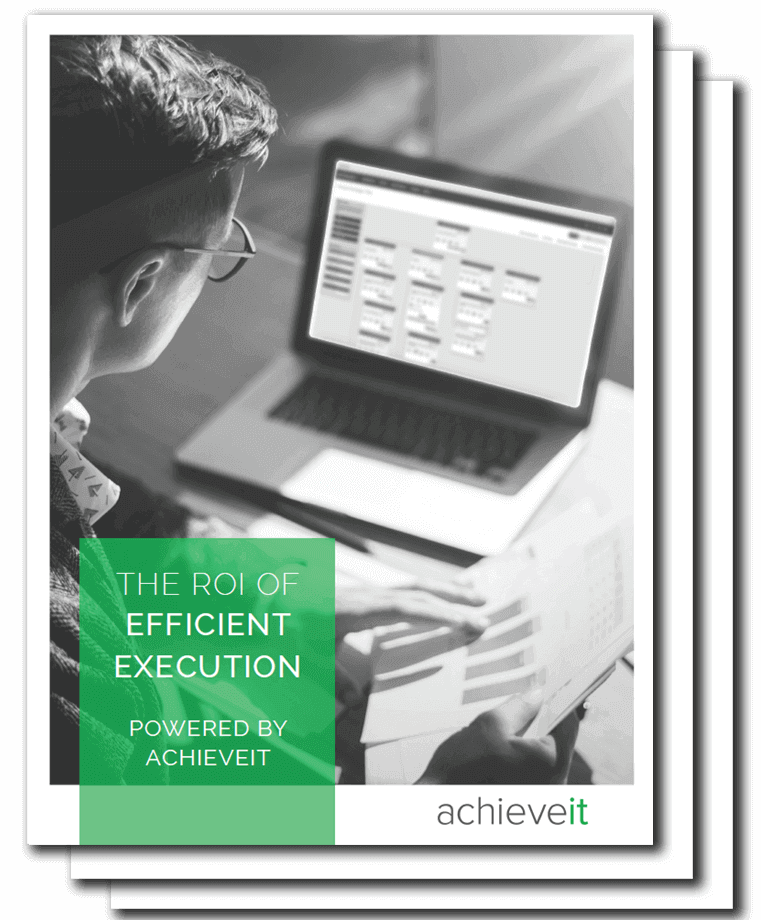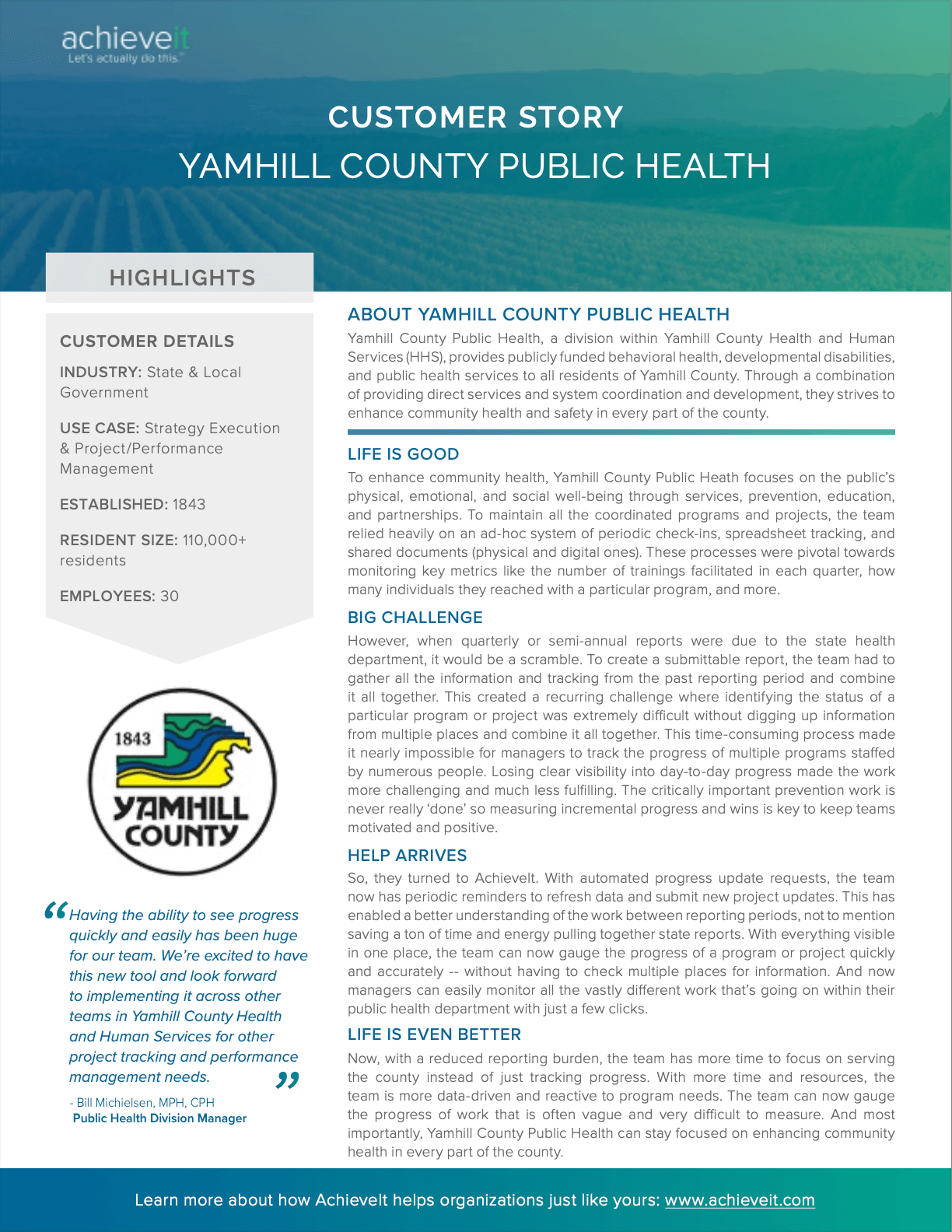You’ve invested significant time and resources in developing a strategic plan, and now you’re eager to track its progress and evaluate its impact. Naturally, you want to keep a close eye on the execution and measure the results. Quarterly tracking seems like a reasonable approach, giving you enough time to assess performance and make the necessary adjustments. However, as the strategy leader, you quickly realize that manually managing the reporting process is taking up a considerable portion of your valuable time.
Instead of focusing on the strategic activities you’re meant to do — such as guiding the implementation, aligning stakeholders, and driving results — you find yourself trapped in an endless cycle of gathering updates. It consumes more than half of your time: chasing individuals for progress updates, scheduling meetings, deciphering unclear information, following up for clarification, and finally, compiling everything into a cohesive report.
But it doesn’t have to be this way. An integrated plan management solution allows you to transform how you track and report on your strategic initiatives. With automation, real-time updates, and powerful data visualization, the solution empowers you to reclaim your time and achieve greater strategic effectiveness.
Why Do Teams Spend So Much Time Collecting Updates?
The short answer to this question is: because you’re using manual processes to collect your updates. “We’ve seen it take some organizations anywhere between four to six weeks to carry out their quarterly update process. That means those insights are available to you halfway through the next quarter,” says Jonathan Morgan, AchieveIt’s VP of Revenue Operations and Head of Marketing.
Manually collecting updates means strategy leaders spend a significant amount of time:
- Sending out emails and asking different team members for updates
- In some cases, sitting in long, drawn-out meetings to obtain these updates
- Verifying and cross-checking the data and information
- Collecting, compiling, and standardizing all of the different reports and updates
- Creating different presentations and documents for different stakeholders
- Going back and forth between stakeholders and the people who provided the information to clarify follow-up questions
“When you think about it, strategy managers are being paid too much to be collecting updates. They should be guiding the organization and making strategic decisions, but instead, they’re spending around 70% of their time dealing with these updates.”
Jonathan Morgan
The repercussions of all of this are:
- Wasted time and resources. This applies not just to the person collecting the updates but also to everyone else involved. Team members have to write out updates from scratch every time and field multiple follow-up questions.
- Outdated insights. Spending four to six weeks carrying out your quarterly update process is more than just a massive inconvenience for your team, “but by the time you actually have that data, you’re halfway through the quarter. It could be totally irrelevant now,” says Jonathan.
- Decisions cannot be made confidently. Because of this delay in obtaining insights, decisions cannot be made based on the most relevant and timely data. You have probably missed opportunities to make decisions four to six weeks ago that could have positively impacted where you are today.
This doesn’t have to be the case. Automating your update collection process can significantly reduce the time and effort it takes to obtain important organizational insights.
FREE RESOURCE
The ROI of Efficient Execution
Download this guide and the companion calculator worksheet to show your team what you’re leaving on the table without enabling plan visibility, organizational alignment, or automated accountability.

Obtain Insights Fast With Integrated Plan Management Solutions
One of the main benefits of using integrated plan management (IPM) software for strategic planning and execution is that the process of update collection and reporting is improved significantly. When an organization creates its plan using an IPM like AchieveIt, it is prompted to set up different items like:
- Themes
- Departments
- Goals
- Objectives/metrics/KPIs
- Strategies
- Tactics
- Projects
The strategy leader assigns each one of these items to a person who will be responsible for its implementation. An update frequency is also assigned that dictates how often updates are required from the person responsible.
If you require a weekly update on a line item, the person responsible will receive an email every week indicating how many items they need to provide updates on. They click a button within that email that takes them directly to the updates page without needing to log in.
They update any metrics, KPIs, or objectives that are pending and change the status color between red, green, and yellow (e.g., off track, on track, or at risk), and provide commentary on each update.
Each input will update the system in real-time, which will be automatically reflected in things like dashboards and reports.
Benefits of an Automated Reporting Process
Implementing an integrated plan management solution for reporting brings numerous benefits that revolutionize the way organizations track and evaluate their strategic initiatives.
- Less manual effort: Strategic leaders spend less time chasing people and updates. The solution streamlines data collection, eliminating the need for repetitive follow-ups and manual consolidation. This frees up valuable time, allowing leaders to focus on more critical tasks.
- Quicker availability of insights for better decision-making: Real-time updates provide timely insights for decision-making. Instead of waiting until midway through the next quarter, decision-makers have access to accurate and up-to-date information. This empowers them to make informed decisions promptly, leading to a more agile and responsive strategic execution.
- Increased reporting frequency without an added burden: Since the process is streamlined and efficient, reporting can be done in a shorter time frame. If reporting only takes two days to complete, it becomes feasible to report more frequently, ensuring that insights remain relevant and actionable.
- Time and resource savings: Instead of conducting lengthy team meetings to collect updates, where significant time and resources are consumed, the updated information is readily available. This allows for more meaningful discussions on decision-making, progress, and challenges. Consequently, the frequency or length of these meetings can be reduced, resulting in substantial time and resource savings.
- Quick follow-up and comprehensive history: An integrated plan management solution offers a dashboard that provides a comprehensive history of updates. If a particular key performance indicator (KPI) is off track, decision-makers can quickly access the relevant information and review the entire history. This facilitates efficient follow-up discussions, enabling timely interventions and corrective actions to get initiatives back on track.
- Development of a standardized reporting protocol: Implementing an automated reporting process promotes the development of a standardized reporting protocol across departments. This standardized approach enhances transparency, alignment, and collaboration, leading to more effective strategic planning and execution.
By embracing an automated reporting process through integrated plan management software, organizations can unlock these benefits, enabling them to optimize their strategic reporting efforts and drive successful execution.
FREE RESOURCE
Yamhill County Public Health Customer Story
Read this customer story to better understand how a local health agency reduced reporting time and gained real-time status clarity with AchieveIt.

How AchieveIt Transformed Reporting for Yamhill County Public Health
Prior to using AchieveIt, Yamhill County Public Health relied on an ad-hoc system for its reporting process. It combined periodic check-ins, spreadsheet tracking, and shared documents to monitor key metrics and coordinate programs. However, when quarterly or semi-annual reports were due, the team scrambled to gather and consolidate the necessary information. This laborious process hindered their ability to track progress effectively and made the work less fulfilling.
By implementing automated progress update requests through AchieveIt, the team experienced a significant shift. They now receive periodic reminders to refresh data and submit new project updates, allowing for a better understanding of the work between reporting periods. With all the information consolidated in one place, managers can effortlessly monitor the progress of multiple programs and projects, eliminating the need to search across various sources.
The benefits were substantial. Yamhill County Public Health witnessed a reduced reporting burden, freeing up time to focus on serving the community and making more data-driven decisions. The team gained clearer visibility into program progress, fostering motivation and positivity. With AchieveIt, the agency became more efficient, reactive to program needs, and able to measure the often elusive progress of its vital work.
To delve deeper into the transformative power of AchieveIt for Yamhill County Public Health and discover how it can revolutionize reporting processes for your organization, read the full case study here.



